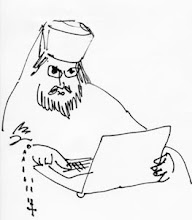Fr Michael Plekon’s final chapter is entitled “Holiness in Our Time.” In it, he seeks to bring home the lessons learned from the figures studied, reminding us that we, too, are called to holiness. It is full of touching anecdotes about several of the figures studies. But once again the perspective is an ecumenical one:
Fr Plekon himself writes as if there were no division. Speaking of contemporary saints, he writes:
I am greatly indebted to Metropolitan Kallistos for making this point in his Afterword:
The century was on of enormous challenge and change for the Christian faith and for the Church in the truly ecumenical sense. I mean the Church everywhere and all of the Church. The Roman Catholic Church experienced a springtime of renewal, the Second Vatican Council being the high point of a new opening attitude to the world, greatly encouraged by the pastoral activity of Popes John XXIII, Paul VI, and John Paul II.Again we are called to act as if there were no division: “The less known, more quiet examples are not the healing of the schisms but nevertheless moments of reconciliation, acts of Christians behaving as if there were no division.”
Fr Plekon himself writes as if there were no division. Speaking of contemporary saints, he writes:
In our time they include the desert hermit Charles de Foucauld, the Yupik priest’s wife and healer Olga Arsamquq Michael, the journalist and radical social activist Dorothy Day, the writer Flannery O’Connor, the author and monk Thomas Merton, and the lover of paradoxes Simone Weil.”
I am greatly indebted to Metropolitan Kallistos for making this point in his Afterword:
Father Michael would, I am sure, be the first to acknowledge that he could easily have chosen an altogether different gallery of “living icons.” He could, for example, have placed much greater emphasis upon the so-called Neopatristic tendency within the Russian emigration. The names of its leading spokesmen, Archpriest Georges Florovsky and the layman Vladimir Lossky, do indeed appear from time to time in this book, but each could have formed the subject of an entire chapter. More could also have said about the contribution made to this Neopatristic current by two theologians who do figure in the book, Fr Alexander Schmemann and Fr John Meyendorff: the first with his research on the early liturgy, the second with his studies on patristic Christology and fourteenth-century Hesychasm.As I wrote in my initial post, I went into my reading of this book with an open mind; I genuinely wanted to understand how Orthodox of a different vision saw the world. I have emerged, I’m afraid, more of a reactionary than when I started. My weariness of ecumenism has only increased, and I now tremble at the word “eschatological.” If one wants to view Orthodoxy through this other vision first hand, I can’t recommend a better book.
It would likewise have been possible to include, among the “persons of faith” in twentieth-century Russian Orthodoxy, such representatives of the ascetic and monastic tradition as St. Silouan of Mount Athos and his disciple Archimandrite Sophrony (Sakharov). In this connection much might have been said about the influence of The Philokalia and the Jesus Prayer, not only within the Russian Church but throughout the Orthodox world and far beyond. This surely constitutes one of the most constructive elements in the witness of contemporary Orthodoxy. And, passing outside the Russian world, there are Archpriest Dumitru Staniloae and Elder Cleopas in Romania, Panagiotis Nellas and Protopresbyter John Romanides in Greece, and Philip Sherrard in the West (I limit myself, as Fr Michael does, to those already dead).









1 comment:
"The Roman Catholic Church experienced a springtime of renewal, the Second Vatican Council being the high point of a new opening attitude to the world, greatly encouraged by the pastoral activity of Popes John XXIII, Paul VI, and John Paul II."
Amazing how blind some "ecumenically-minded" Orthodox are to the reality of post-Conciliar Catholicism. Do these Orthodox realize that the more they speak this way, the more they encourage the modernists who want to destroy anything that remotely smacks of traditional Christianity in East and West? Catholics have no need for such "friends".
Post a Comment